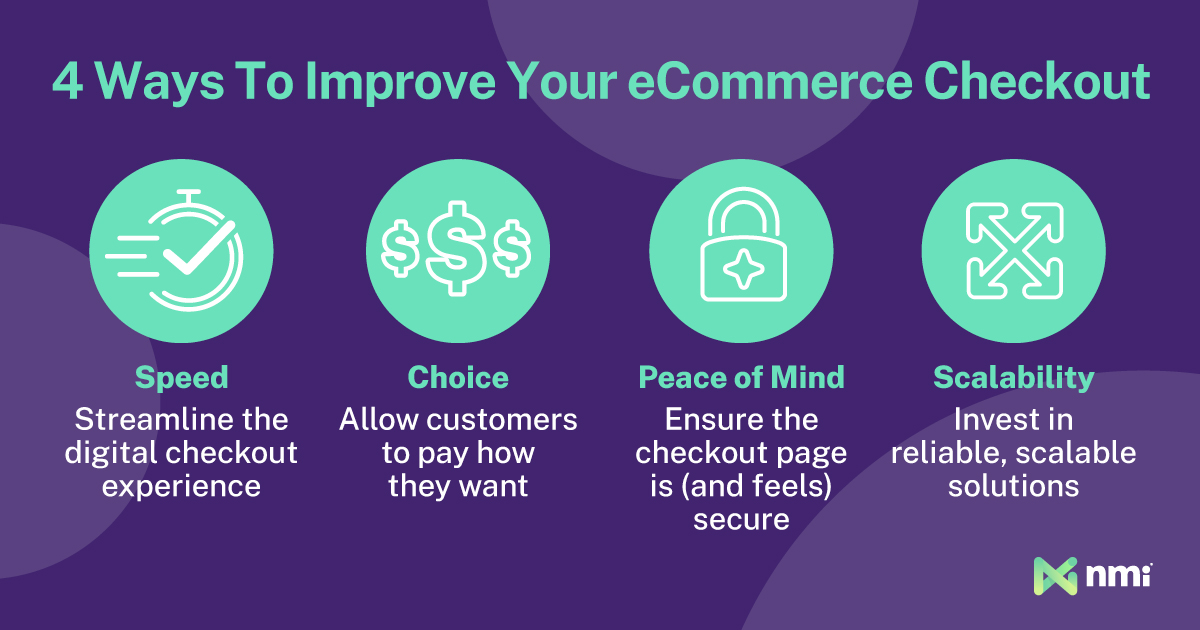People like buying things online; ecommerce is fast, convenient and allows consumers to shop from merchants worldwide. With 24% of retail purchases expected to occur online by 2026, it’s no surprise that the rate of digital sales is growing. As younger, more tech-savvy shoppers enter the workforce and gain buying power, having an ecommerce presence will become increasingly crucial for merchants.
However, there’s more to a great ecommerce experience than meets the eye. According to research from the Baymard Institute, a think tank focusing on online user experience, consumers abandon over 70% of ecommerce carts.
Many shoppers abandon their carts because of a lackluster checkout experience, while others do so because of unexpected fees. According to recent reports:
- 47% of consumers report abandoning their carts because of additional costs, including shipping, taxes and other fees
- 19% say they didn’t trust the site with their payment information
- 18% cite a long or complex checkout process
- 11% say there weren’t enough payment methods available
Fortunately, these are avoidable problems, and solving them can recapture a significant number of lost sales. To provide customers with the best ecommerce checkout experience, merchants (and their payment providers) can address four main areas: speed, choice, peace of mind and scalability.
Offer Speed: Streamline Checkout for Maximum Efficiency
Modern payments are all about convenience. Recent research from NMI found that 84% of consumers said convenience was a top priority in selecting a payment method. Speed was the second most important factor cited, at 49%.
A great checkout experience should make it as fast and frictionless as possible to get a customer from a product page or shopping cart to a completed order confirmation screen. Two ways to accomplish this include offering one-click checkout options and storing card data for future purchases.
One-Click Checkout
One-click checkouts eliminate friction from the payment process. Although Amazon pioneered one-click checkouts, “buy now” options are taking hold across the ecommerce landscape.
New research from Cornell University found that customers not only return to sites with one-click checkout more often (and buy a wider range of products) but also spend 28.5% more on average.
TBusinesses can enable one-click checkout in several ways. Digital wallet adoption is a great start. It enables customers to perform a one- or two-click checkout through a “buy now” button on the page or through the wallet app.
For a more robust solution, merchants can consider account-based options that require a user to log in, similar to Amazon’s model. However, it’s important to remember that account creation should be optional. Forcing shoppers who don’t want an account to log in will lead to higher cart abandonment. Instead, enable customers to purchase through an account or as a one-time guest.
Securely Saved Card Data:
TAmazon-style checkouts use stored payment data to enable future one-click transactions. While modern consumers are less hesitant about saving a payment method online, storing card data still presents security challenges.
For instance, stored card data is a target for cybercriminals. Because of this, storing sensitive data on internal servers can elevate the risk of a data breach. Thankfully, there are one-click solutions that don’t require merchants to store payment data themselves.
One option is a PCI-DSS-compliant third-party storage service like NMI’s Customer Vault. Third-party customer data storage shifts the burden (and liability) away from the merchant and onto a partner with the resources and experience needed to offer air-tight cybersecurity. With off-site data storage, the partner will issue merchants unique tokens with encrypted payment data so they never directly interact with sensitive information.
Offer Choice: Tailor Payment Options to Evolving Customer Preferences
Consumers are always looking for ecommerce experiences that meet their unique payment needs. Often, if a merchant doesn’t provide their preferred payment method, they will look to a competitor who will.
Accepting credit cards and debit cards is necessary for online shopping. Beyond these basics, there are several payment types online shoppers look for, including digital wallets, ACH payments, real-time payments and buy now, pay later (BNPL). Offering more ways to pay is a great way to improve customer satisfaction and retention.
Ensure Digital Wallet Payments Are Available
Digital wallets like Apple Pay and Google Pay are now the most popular online payment method around the globe. Half of ecommerce payments are made with digital wallets, and that number is growing.
Prominent digital wallet providers, like Google Pay and Apple Pay, enable digital wallet use at the device and browser level. This means a customer can use these options to pay even if a merchant’s site doesn’t specifically offer them.
However, not all consumers use these two options. As more digital wallets emerge in the marketplace, offering this type of payment acceptance directly (on an ecommerce site or through a payment gateway) will become more important.
The good news is that all top ecommerce platforms make it easy to accept digital wallet payments. Some platforms offer this feature automatically. Others, like BigCommerce, require merchants to toggle on the option in their site’s control panel. Enabling customers to pay online with a digital wallet will improve the shopping experience and reduce your risk of cart abandonment.
Consider Enabling ACH/eCheck Payments
ACH (Automated Clearing House) payments are the third most popular digital payment option among American consumers, behind debit and credit cards.
For ecommerce merchants, ACH payments are processed in the form of eChecks—electronic payments that function similarly to paper checks. However, unlike paper checks, there are verification steps merchants can take to ensure electronic checks don’t bounce. They’re also cheaper to process than credit card payments and offer fewer restrictions for merchants in high-risk industries.
To offer customers eCheck payments, merchants need a gateway with built-in ACH capability. eChecks are a low-friction way to provide consumers with more choices. Plus, their ease of acceptance makes them an excellent option for many online businesses.
Prepare for Instant A2A Payments
While ACH is a fantastic choice for many merchants, it can be slow. Direct bank payments are a popular alternative to digital checks. They are quick and convenient, using real-time payment (RTP) networks to send money directly from a bank account.
The launch of the new FedNow network in the United States aims to bring RTP to more American consumers, aligning U.S. adoption with Europe. As overall RTP adoption grows, account-to-account (A2A) payments will also become more popular. A2A payments perform the same function as eChecks, but they clear instantly, offering significant benefits to merchants and their customers.
Make Shopping More Accessible With BNPL
Economic constraints make shopping a struggle for many consumers. Even necessities can be difficult to justify when upfront costs are too high or credit isn’t available. Buy now, pay later (BNPL) allows consumers to split their purchases into several interest-free installments. The first is due at checkout. Then, the buyer makes payments until their balance is paid.
BNPL platforms offer payment flexibility with no risk to the merchant. As economic conditions tighten, consumers may rely more heavily on BNPL to cover the cost of everyday purchases, including groceries, rent and gas.

Offer Peace of Mind: Make Checkout Feel Secure for Shoppers
Most of today’s ecommerce sites are highly secure; they have built-in security and fraud prevention and follow stringent government and industry compliance regulations. So why would consumers hesitate to give their payment information to a merchant?
There will always be consumers, generally in older demographics, who are less comfortable paying online. Thankfully, there are three things merchants can do to help uncertain consumers feel more secure during checkout. These include using familiar branding, providing clear instructions and polishing the checkout site’s design.
- Branding: When a consumer checks out, the experience should feel seamless. Sending a buyer to a secondary site or showing a third-party logo during checkout could confuse and spook a buyer. Instead, merchants should opt for a white label payment solution that features their own branding and integrates seamlessly into the rest of their website
- Clarity: Customers shouldn’t have to search for the information they need on the checkout page. For instance, Amazon’s checkout emphasizes key information like the customer’s details, cost breakdown and delivery date. The page also includes a summary of the company’s return policy and links to detailed pages covering returns, delivery fee calculations, regulatory fees and more. Any information a customer may need is one click away
- Design: The checkout experience needs to feel modern to feel secure. That’s true for every page of an ecommerce site, but it’s especially true for checkout and payment pages. If a customer feels that the user interface and forms are clunky or outdated, they may question the merchant’s credibility. Adopting ecommerce payment systems that look and feel modern will help mitigate customer concerns and improve confidence in the seller
Customer expectations are rising, and any degradation in service as a merchant grows will be noticeable. Adopting checkout and payment systems that are highly scalable is the best way to avoid these issues.
Large, well-established payment providers (who have built their businesses and services with scale in mind) are ideal partners for growing businesses. Plenty of merchants plan for failure, but few plan for runaway success. Highly scalable backend systems are critical to long-term profitability and growth.
Help Merchants Create an Ideal Online Payment Experience With NMI
Seamless ecommerce checkout and payment experiences can make or break a business. Merchants can’t afford to lose customers to more tech-savvy competitors; luckily, they don’t have to. NMI’s one-stop payment platform offers everything merchants need to deliver an ideal online payment experience that minimizes cart abandonment and maximizes revenue.
To learn how NMI’s payment platform can help your merchants create a modern, frictionless payment experience, reach out to a member of our team.
Don’t just turn on payments, transform the way you do business
- Generate New Revenue By adding or expanding payment offerings to your solution, you can start earning higher monthly and transaction-based recurring revenue.
- Offer the Power of Choice Allow merchants to choose from 125+ shopping cart integrations and 200+ processor options to streamline their onboarding.
- Seamless White Labeling Make the platform an extension of your brand by adding your logo, colors and customizing your URL.





